You’ll find Tucson is built for outdoor lovers and culture seekers alike, with towering saguaros, winding mountain roads, and a lively arts scene to explore at your own pace. Hike iconic trails, wander historic neighborhoods, and sample Sonoran‑style eats while spotting wildlife and colorful murals. Stay for sunset drives and museum stops, and you’ll soon see why this desert city keeps pulling people back for more—here’s what to try first.
Explore Saguaro National Park East (Rincon Mountain District)
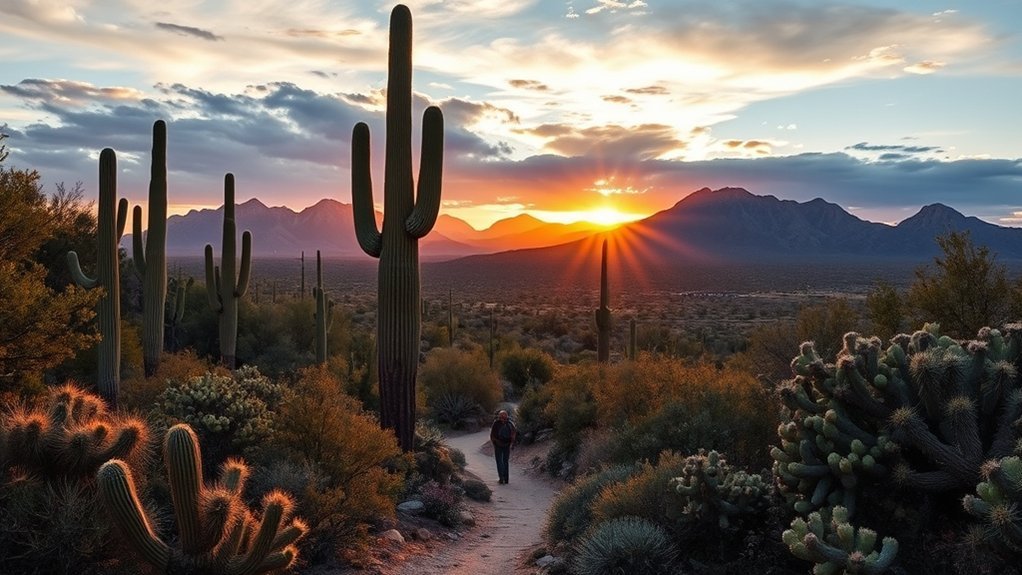
If you head east of Tucson into the Rincon Mountain District, you’ll find Saguaro National Park‘s classic desert-scape—vast stands of towering saguaro, rugged bajadas, and wide-open skies that change color with the sun. You’ll start at the visitor center to get maps, learn about seasonal conditions, and spot hiking suggestions tailored to your fitness level. Take the scenic Cactus Forest Drive to see saguaros clustered like sentries; pullouts offer photo ops and short interpretive trails where you’ll read about wildlife, geology, and cultural history. Hike trails such as Mica View or Douglas Spring to experience varied elevations, desert wildflowers in spring, and quiet riparian pockets after rains. You’ll want water, sun protection, and layered clothing—temperatures swing fast. Keep an eye out for Gila monsters, coyotes, and nesting raptors, but leave wildlife undisturbed. At sunset, the silhouettes of saguaros against pink and purple skies make a memorable finish to a day exploring this iconic Sonoran landscape.
Hike Sabino Canyon Recreation Area
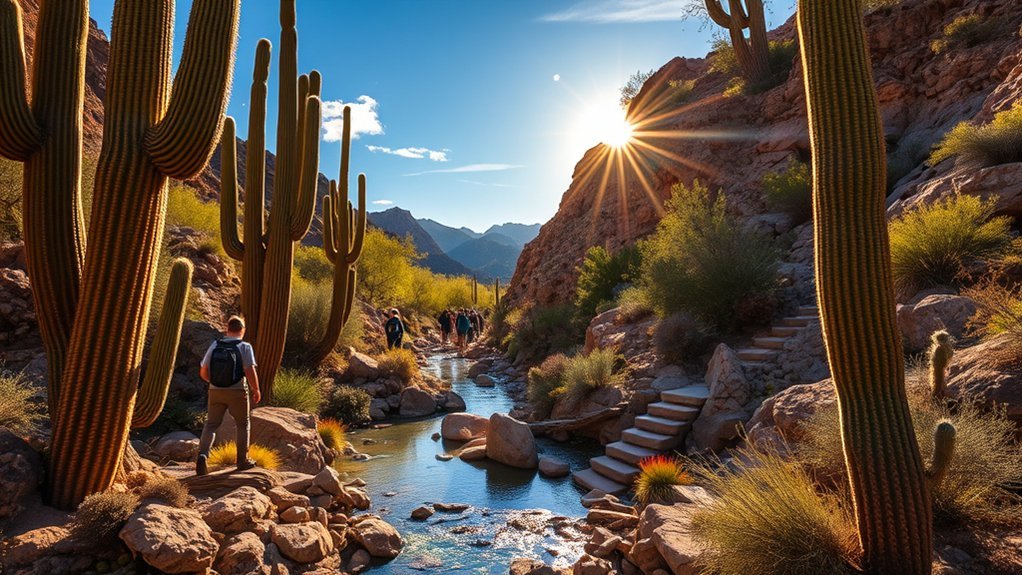
Head to Sabino Canyon and you’ll find a range of trails from easy washes to steep ridgelines, so pick one that matches your fitness and time. Use the seasonal shuttle/tram to access trailheads and save your energy for hiking the scenic spots where granite cliffs, sparkling pools, and desert flora meet. Keep your eyes peeled for javelina, mule deer, and raptors as you explore—wildlife sightings and viewpoints are highlights throughout the canyon.
Trail Options & Difficulty
Although Sabino Canyon looks tame from the road, once you step onto its trails you’ll find routes that suit every fitness level—from gentle washes and paved paths perfect for families to steep, rocky climbs that reward you with panoramic desert views. You can choose short interpretive loops, moderate canyon routes with seasonal streams, or strenuous ridgelines that test your footing and stamina. Trail markers are clear but pack water, sun protection, and good shoes. Wildlife sightings and changing light keep hikes interesting. Use the table below to match trail type to effort and highlights so you pick the right outing for your group.
| Trail Type | Difficulty | Highlights |
|---|---|---|
| Paved loop | Easy | Family-friendly, accessible |
| Canyon wash | Moderate | Seasonal water, shade |
| Ridge/summit | Hard | Views, rugged terrain |
| Connector trails | Variable | Link routes, explore |
Shuttle & Tram Info
At Sabino Canyon, the shuttle and narrated tram make exploring the recreation area easy—especially on busy weekends when vehicle access is limited—so you can leave the driving to the rangers and focus on the scenery. You’ll board at the visitor center; tickets are required and popular times sell out, so arrive early or reserve if offered. The tram follows a loop with seven stops, letting you hop on and off to hike specific trails without backtracking. Narration points out trailheads, history, and safety tips, helping you plan where to get off. Service varies seasonally; check schedules, fares, and accessibility options before you go. Bring water, sun protection, and a small pack for short walks from the stops.
Wildlife & Scenic Spots
Once you step off the tram and onto the canyon trails, you’ll find Sabino’s mix of riparian pools, rocky ridgelines, and saguaro-studded slopes offers rich wildlife viewing and striking vistas within short walking distance. You’ll hear canyon wrens, spot Gambel’s quail scurrying through brush, and maybe catch sight of mule deer or a roadrunner along the wash. Creeks and shallow pools sustain dragonflies and seasonal amphibians, while higher ridgelines give panoramic views of Tucson and the Rincon Mountains. Bring water, sun protection, and binoculars; stay on trails to protect habitat. Consider an easy stroll or a longer out-and-back to match energy and daylight.
- Carry water and sun protection
- Use binoculars for birds and distant mammals
- Stick to trails to preserve habitat
- Time visits for early morning wildlife activity
Visit the Arizona-Sonora Desert Museum
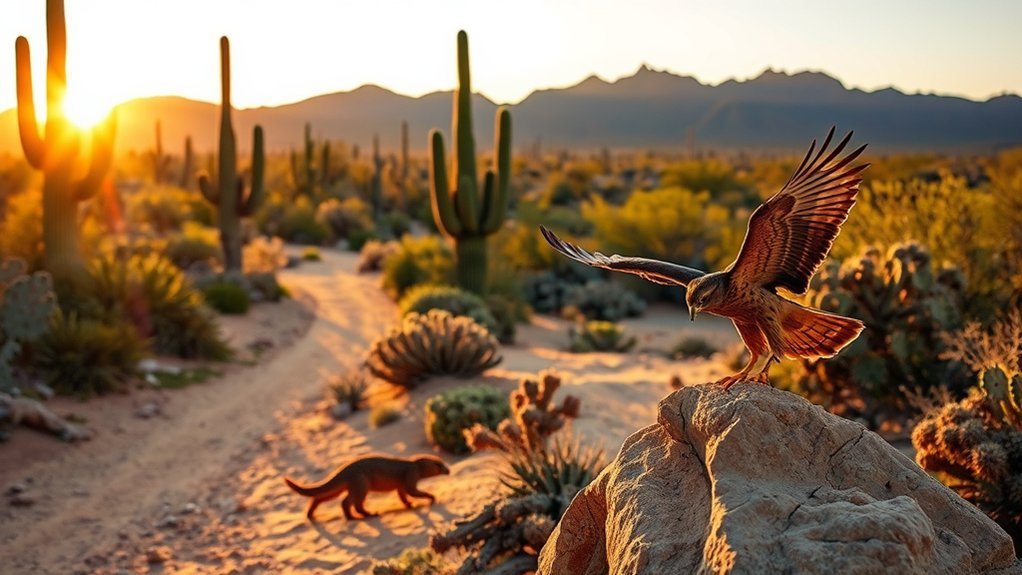
At the Arizona-Sonora Desert Museum you’ll walk through living desert habitats that feel like stepping into the Sonoran landscape itself. Expect close-up wildlife encounters—rangers often bring out owls, raptors, and reptiles—and daily shows that explain how these animals survive the heat. Plan a couple of hours so you can catch at least one live presentation and explore the trails.
Living Desert Habitats
While wandering the Arizona-Sonora Desert Museum, you’ll step into living desert habitats that showcase the region’s plants and animals in naturalistic settings, not behind bars. You’ll wander trails where spiny cholla, saguaro, and ocotillo form the backdrop, and seasonal blooms color rocky slopes. Interpretive signs explain adaptations—water storage, reflective surfaces, nocturnal behavior—so you’ll understand survival strategies. You’ll notice microhabitats: washes that funnel rain, rocky crevices that shelter lizards, and pollinator gardens attracting hummingbirds.
- Observe plant adaptations up close.
- Learn how desert ecosystems cycle water and nutrients.
- See how terrain shapes animal behavior.
- Use shaded trails and viewing platforms for comfortable, respectful wildlife observation.
The exhibits teach stewardship of fragile arid landscapes without sensationalism.
Wildlife Encounters & Shows
After exploring the living habitats and seeing how plants and terrain shape animal life, you’ll find the museum’s wildlife encounters and shows bring those lessons to life through close-up demonstrations and expert narration. You can watch raptors glide in an aerial presentation that highlights hunting strategies and conservation challenges, or attend keeper talks where reptiles, small mammals, and invertebrates are handled safely while staff explain behavior and adaptations. These programs let you ask questions, see scale and movement up close, and understand desert survival in a vivid, memorable way. Timed feedings and nocturnal house tours reveal rhythms you wouldn’t notice on a daytime walk. Check the schedule, arrive early for good seats, and expect to leave with a sharper appreciation for Sonoran life.
Wander Historic Fourth Avenue
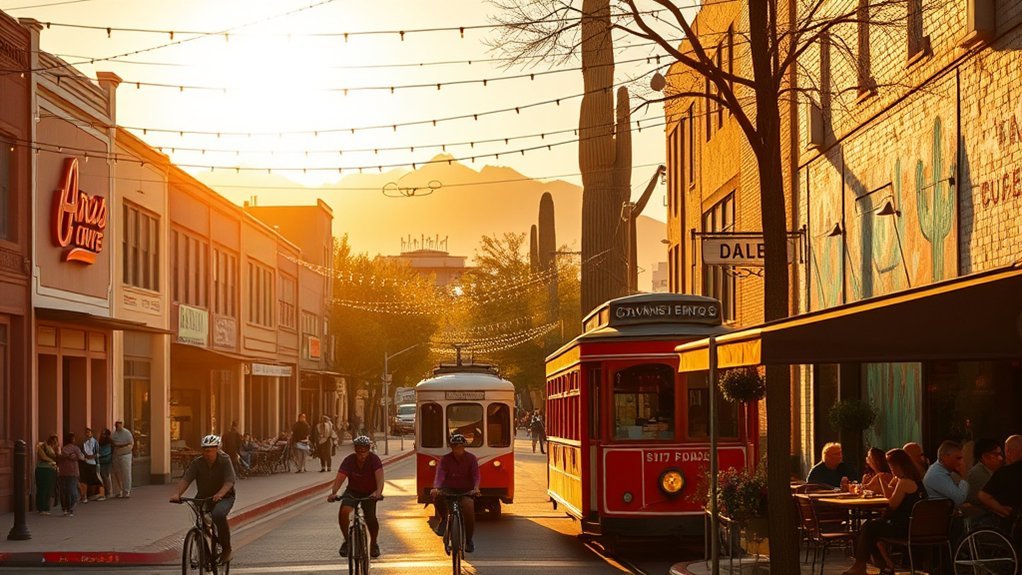
Wander down Historic Fourth Avenue and you’ll find a lively stretch where colorful murals, quirky boutiques, and cozy cafes line a walkable, palm-studded street. You’ll feel the neighborhood’s creative energy as you stroll, popping into artisan shops that sell handmade jewelry, vintage finds, and local art. Stop at a café for a strong espresso or an iced tea, then sit outside and watch street life drift by—bicycles, students, and friendly dogs. Keep an eye out for rotating gallery shows and weekend markets that showcase Tucson’s makers. The avenue’s mix of independent retailers and relaxed eateries makes it easy to craft a personalized afternoon: browse, snack, and people-watch. Plan around late-afternoon light when murals glow and shop owners are often available to chat. To help focus your visit, consider these highlights:
- Independent boutiques for unique souvenirs
- Street murals and public art installations
- Cafés and bakeries for casual bites
- Weekend markets and pop-up events
Tour Mission San Xavier Del Bac
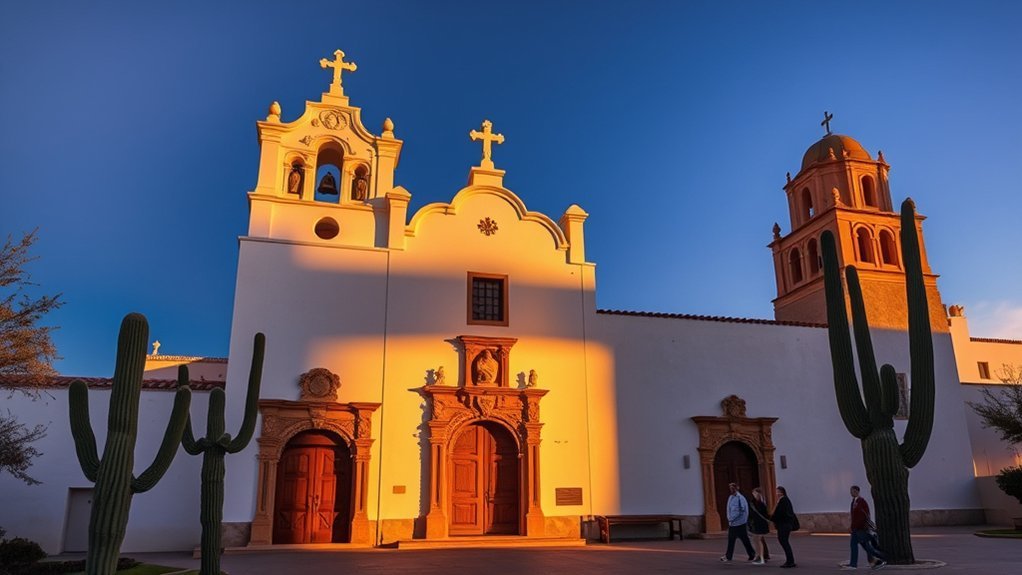
Step inside Mission San Xavier del Bac to step back into 18th‑century Arizona, where ornate white stucco walls, carved wooden altarpieces, and vivid frescoes create a luminous, otherworldly interior. You’ll notice the blend of Spanish colonial architecture and Tohono O’odham craftsmanship—intricate carvings, stucco saints, and polychrome angels that have been carefully conserved. Take a guided tour to learn about Father Kino’s founding, the mission’s role as a living parish, and the restoration efforts that preserve its delicate murals. Photograph details respectfully; the church remains active, so check service times and dress modestly. Outside, wander the peaceful courtyard and observe the desert backdrop against the mission’s striking silhouette. Seasonal events and feasts bring traditional dances and pottery vendors, offering a glimpse of contemporary indigenous culture. Whether you linger for quiet reflection or a focused history lesson, the mission rewards attentive visitors with beauty, context, and a tangible sense of Tucson’s layered past.
Stroll Through Old Tucson Studios
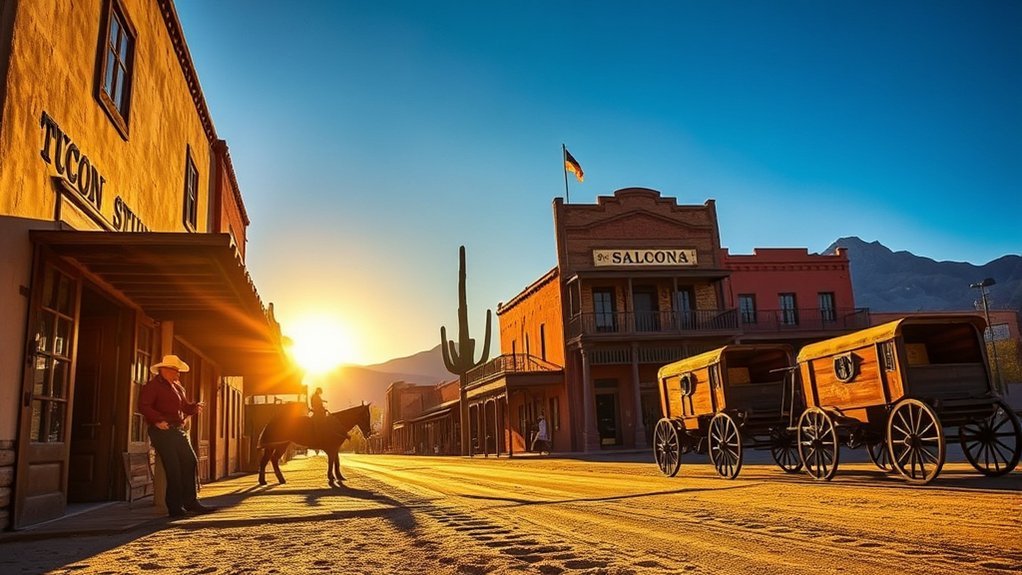
You’ll feel like an extra on a classic Western as you wander the preserved streets and soundstages of Old Tucson Studios. Catch lively live shows that recreate gunfights and saloons, then hop on period rides for a hands-on taste of frontier fun. It’s a compact, immersive stop that’s great for photos, family entertainment, and movie-history buffs.
Historic Movie Set Walkthrough
Stroll through Old Tucson Studios and you’ll feel like you’ve slipped into a working movie set where dusty streets, saloons, and period storefronts bring classic Westerns to life. You’ll wander dirt lanes lined with painted signs, peek into props-filled shops, and study authentic facades used in films and TV. Informational plaques and friendly guides explain filmmaking techniques, set preservation, and the site’s cinematic history, so you’ll leave with a deeper appreciation for location work. Photography is encouraged, and you’ll notice small details — weathered wood, period lighting, and scenic backdrops — that make scenes believable.
- Study original set pieces and film props.
- Read plaques about production history.
- Ask guides about restoration work.
- Photograph architectural details and backdrops.
Live Western Shows & Rides
Catch a live-action moment as cowboy shootouts, musical saloons, and stunt-packed chase scenes unfold right before you at Old Tucson Studios. You’ll wander through authentic sets where costumed actors toss witty banter, stagecoach holdups erupt with pyrotechnic flair, and choreographed horseback stunts keep your pulse up. Shows run throughout the day, so plan to arrive early to grab a good vantage point and check the schedule for special events like gunfighter duels or heritage demonstrations. Kids love interactive rides and the chance to pan for gems, while adults appreciate the film-history nods and detailed period architecture. Photo opportunities abound; bring sunscreen and comfortable shoes, because you’ll be on your feet exploring this lively slice of the Old West.
Drive Mount Lemmon Scenic Byway
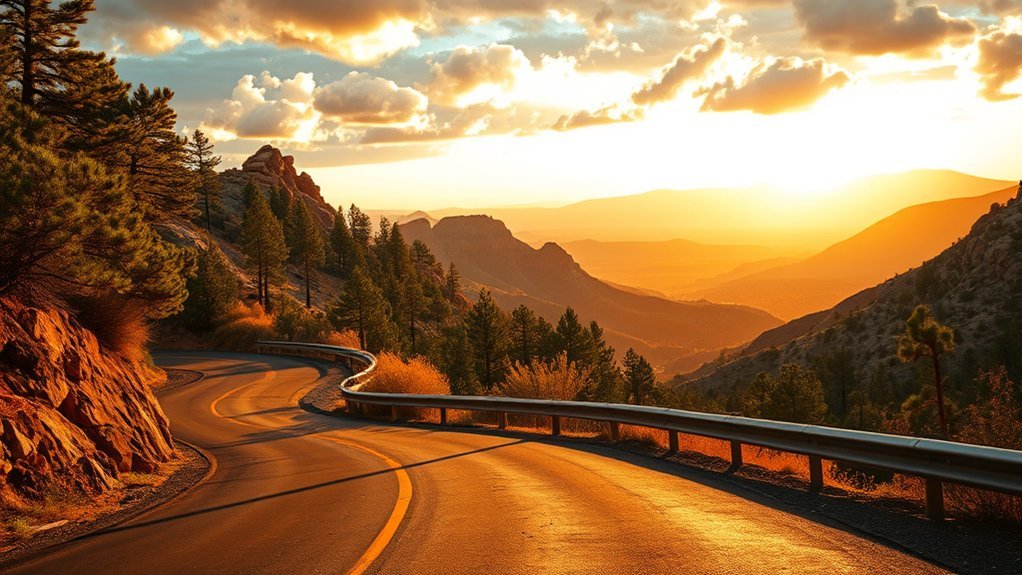
Because the road climbs from desert to pine forest in under an hour, driving the Mount Lemmon Scenic Byway feels like stepping through distinct climates, each with its own color and scent. You’ll start amid saguaro-studded flats, then wind upward through mesquite and oak, finally arriving in cool, fragrant pines. The highway bends reveal sweeping valley views, rocky outcrops and occasional wildlife — javelina, hawks, even deer — so you’ll want to stop at overlooks and pullouts to absorb the panorama.
Plan your drive for clear weather, bring water, and watch your brakes on steep sections. There are picnic sites, trailheads, and small mountain towns where you can stretch your legs.
- Stop at Vista del Sol for sunrise colors.
- Hike a short trail like Aspen or Marshall.
- Picnic among pines at a designated site.
- Park safely at overlooks for photos and wildlife spotting.
Experience the Pima Air & Space Museum
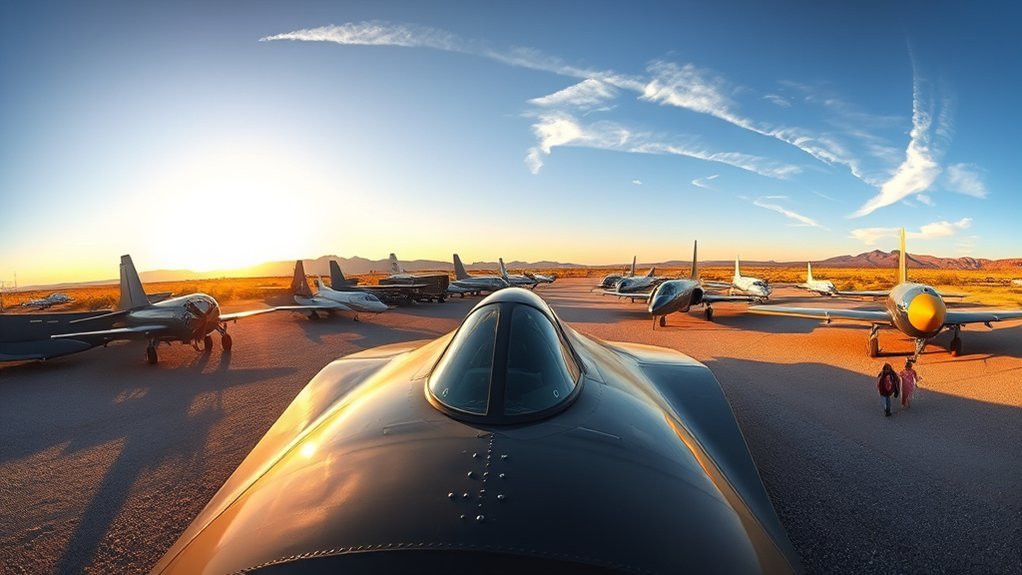
At the Pima Air & Space Museum you’ll walk among more than 300 historic aircraft, from WWII fighters to jumbo airliners, each with stories that bring aviation history to life. You can climb into cockpits, try hands-on simulators, and join guided tours that make complex technology easy to understand. It’s a hands-on, up-close experience that’ll thrill plane enthusiasts and curious visitors alike.
Historic Aircraft Exhibits
Step into the vast hangars of the Pima Air & Space Museum and you’ll find yourself surrounded by more than 350 historic aircraft, each with its own story of innovation, conflict, or exploration. You’ll walk among Cold War fighters, World War bombers, sleek experimental planes, and restored classics, noticing details like rivet patterns, cockpit instrumentation, and faded squadron markings. Exhibits place aircraft in context—technology, missions, and the people behind them—so you come away understanding design choices and historical impact. Audio guides and placards fill gaps without overwhelming. Don’t miss signature pieces that illustrate aviation milestones:
- B-17 Flying Fortress — strategic bombing history
- SR-71 Blackbird — reconnaissance and speed records
- F-14 Tomcat — carrier aviation legacy
- Concorde model — supersonic commercial flight heritage
Hands-On Aviation Experiences
Explore the Pima Air & Space Museum beyond the walkways by jumping into hands-on experiences that bring aviation history to life—try taxiing a full-motion flight simulator, climb into replica cockpits, or handle authentic aircraft components under staff supervision. You’ll feel control yoke resistance, hear turbine whine through headphones, and read real instrument panels as docents explain functions and stories. These immersive activities suit families, students, and aviation fans who want tactile context for the exhibits. Book timed sessions for simulators and cockpit climbs; staff brief you on safety and techniques. Bring a camera — the sensations translate to vivid photos and memories. Below’s a simple visual guide to scenes you might encounter.
| Scene | Sensation |
|---|---|
| Simulator cockpit | Vibrating realism |
| Replica cockpit | Hands-on switches |
| Engine component | Cool metal touch |
| Docent demo | Focused storytelling |
Enjoy Tucson Botanical Gardens
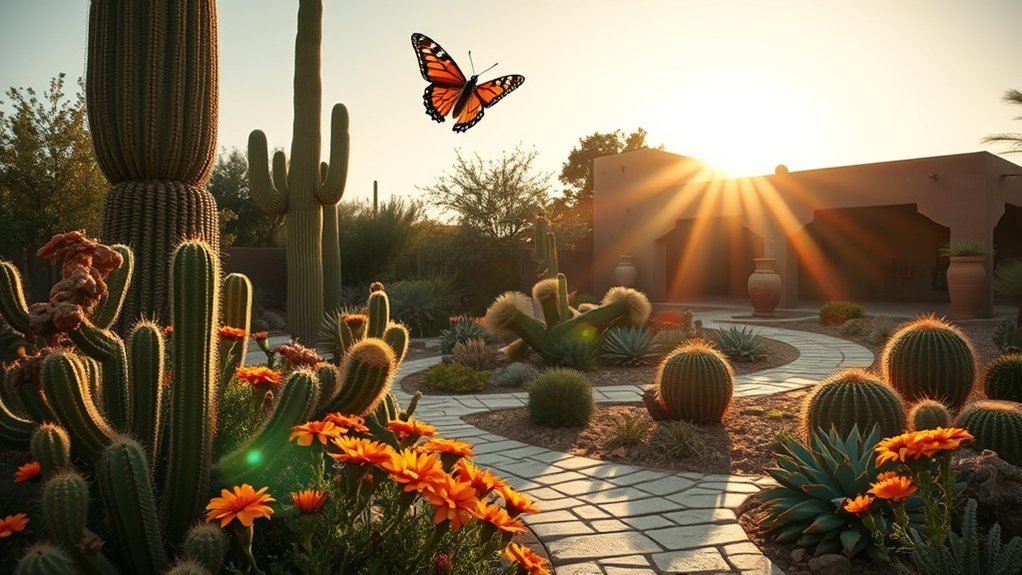
You’ll find Tucson Botanical Gardens a peaceful oasis tucked into the city’s heart, where winding pathways lead through themed gardens, shady courtyards, and a vibrant butterfly exhibit. You’ll wander among desert-adapted plants, fragrant herbs, and a serene water garden that cools the air. Plan to linger on benches beneath palo verde and mesquite trees, watch pollinators at work, and photograph textured agaves and delicate succulents.
A peaceful oasis in the city—winding gardens, shady courtyards, butterflies, and textured agaves for lingering and photographing.
The gardens are ideal for a calming morning walk, a photography session, or a family outing where kids learn about native plants. Seasonal rotating exhibits and docent-led tours add depth, so you’ll get both beauty and context.
- Visit the butterfly exhibit for close-up encounters.
- Join a docent tour to learn plant histories.
- Attend seasonal classes or workshops for hands-on learning.
- Relax in shaded courtyards with a guidebook or sketchpad.
Discover the Tucson Museum of Art
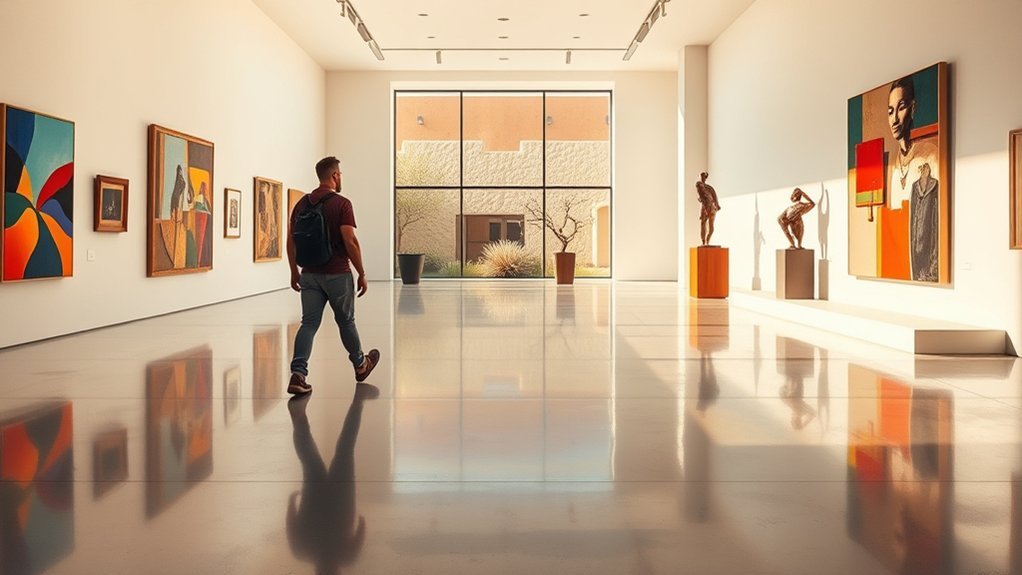
Step inside the Tucson Museum of Art and you’ll find a rich mix of permanent and rotating exhibits that trace regional and international art across eras. Wander the sculpture garden to enjoy outdoor works set against desert light, then check the calendar for concerts, lectures, and family-friendly events. Whether you stay an hour or a whole afternoon, the museum offers fresh perspectives and programs that keep every visit dynamic.
Permanent and Rotating Exhibits
Housed in a sunlit, art-filled campus downtown, the Tucson Museum of Art blends a strong permanent collection—Southwestern and Latin American works, contemporary pieces, and historic American Western art—with lively rotating exhibitions that keep each visit fresh. You’ll move from ceramics and textiles that tell regional stories to modern canvases that challenge expectations. Labels and audio guides help you connect artists’ intentions to local history, and galleries are arranged so you can flow naturally between eras and styles. Rotating shows spotlight emerging talent, thematic groupings, or traveling retrospectives, so there’s always something new to discover.
- Explore regional Indigenous and Spanish-colonial pieces.
- Study contemporary Arizona artists.
- Visit curated thematic exhibitions.
- Check rotating calendars for surprises.
Sculpture Garden and Events
Beyond the galleries, the Tucson Museum of Art extends into a sunlit sculpture garden where you can wander among large-scale works that converse with the desert light and courtyards. You’ll find bronze, stone, and contemporary pieces placed to frame saguaro-studded vistas and intimate seating areas. The layout invites slow discovery: sculptures punctuate pathways, shadow patterns change through the day, and plaques offer context about artists and materials. The museum also programs events here—open-air concerts, artist talks, and seasonal receptions—that let you experience art socially and informally. Check the calendar for First Thursdays and family-friendly workshops that pair exhibitions with hands-on activities. Whether you linger for a sculpture or stay for an evening event, the garden feels like Tucson made tangible.
Attend a University of Arizona Wildcats Game

If you’re in Tucson during football or basketball season, catching a University of Arizona Wildcats game is a must — the energy on and around campus is electric. You’ll feel it the moment you approach Arizona Stadium or the McKale Center: tailgates, marching band rhythms, and sea-of-red camaraderie. Buying tickets in advance helps, but you can often find last-minute seats from friendly fans. Expect passionate crowds, spirited chants, and dramatic plays that keep you on the edge of your seat. Concessions offer classic ballpark and arena fare, plus local twists if you want Sonoran flavors. Parking and transit are straightforward with gameday shuttles and nearby lots, though arriving early reduces stress. If you’re into school traditions, look for the pregame rituals that define Wildcat culture. These games are more than sport — they’re a community celebration that shows Tucson’s pride and warmth firsthand.
Catch a Wildcat game in Tucson — electric crowds, lively tailgates, Sonoran snacks, and unforgettable school spirit.
- Arrive early for tailgates
- Buy tickets ahead when possible
- Use shuttles or park offsite
- Learn a few chants before you go
Walk Through Barrio Viejo
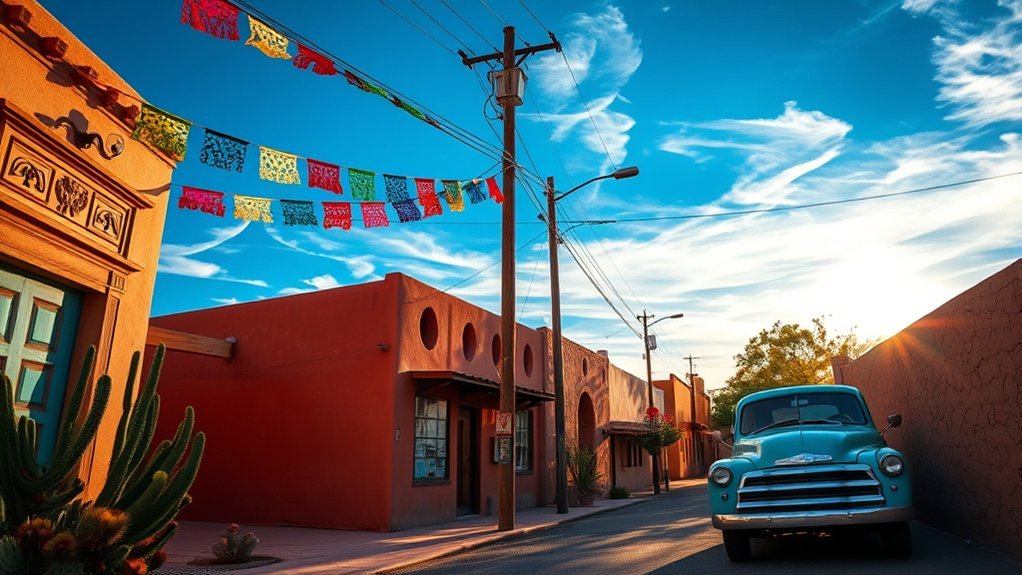
Step into Barrio Viejo and you’ll feel like you’ve stepped back in time — narrow streets, adobe cottages, and vibrant murals reveal Tucson’s layered history at every turn. As you wander, you’ll notice ornate wooden doors, tinwork balconies, and original tile that speak to 19th-century craftsmanship. Look for plaques that explain each home’s story; they’re a quick, rewarding history lesson. Photography is encouraged, but respect residents’ privacy and keep voices low—this is a living neighborhood, not a museum. Pop into small galleries or community arts spaces when you see them; local artists often display pieces tied to Tucson’s Mexican and Indigenous heritage. Wear comfortable shoes—the uneven sidewalks and occasional loose stone demand steady footing. If you visit during a festival or walking tour, you’ll gain richer context from docents who share oral histories and architectural details. Finish your stroll by pausing in a shaded pocket park or courtyard to absorb the neighborhood’s quiet resilience and enduring charm.
Catch a Sunset at Gates Pass
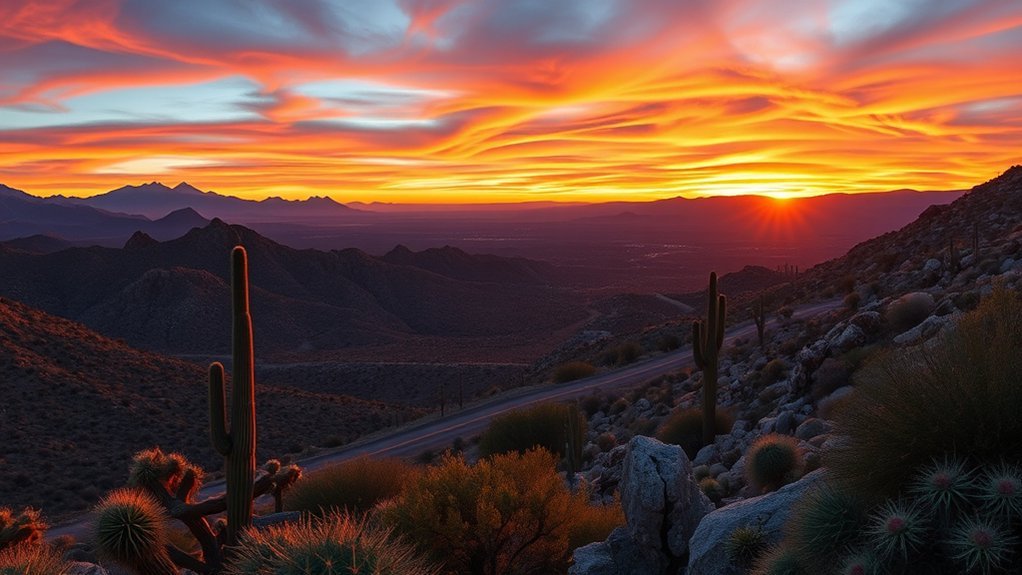
Drive up to Gates Pass as golden hour starts and you’ll find Tucson’s desert silhouette sharpening into dramatic contrast—saguaro-studded ridgelines, rocky outcrops, and the city spread below. You’ll park at the turnout, step out into warm, thinning light, and watch colors deepen: gold to rose to indigo. The wind smells like creosote; the temperature drops a few degrees as the sun slips. You can bring a lightweight blanket, a camera with a wide lens, and patience—the best shows unfold slowly.
- Arrive 30–45 minutes before sunset to claim a spot.
- Use a tripod or steady surface for crisp low-light shots.
- Bring water and layers; desert temperatures fall fast.
- Respect signage and keep to designated areas for safety.
From this ridge you’ll see the valley glow, distant mountain silhouettes sharpen, and city lights begin to twinkle—an intimate, unforgettable desert sunset that’s easy to experience and hard to forget.
Sample Street Food and Restaurants on Congress Street
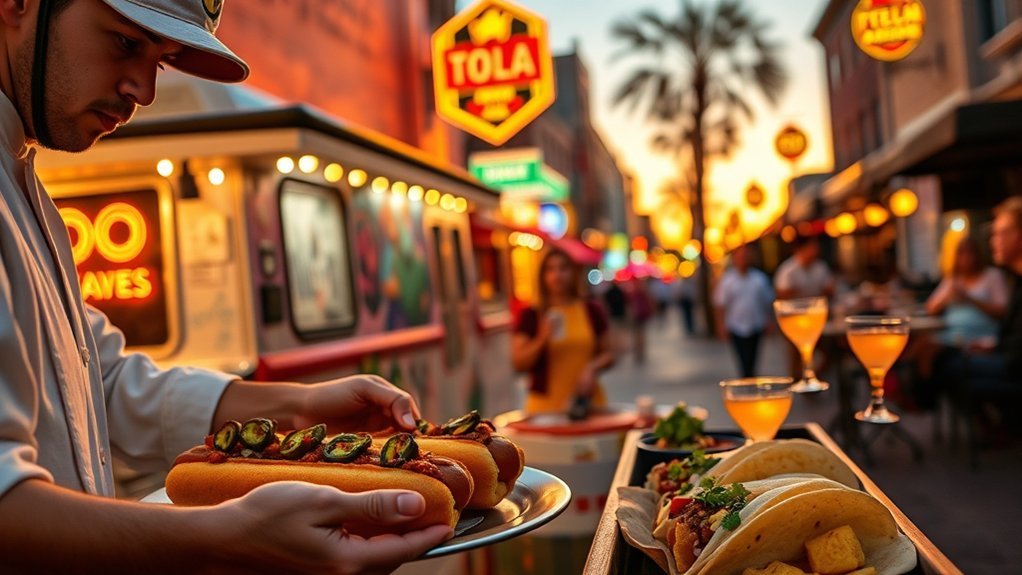
Come hungry and wander Congress Street’s lively strip, where food trucks, casual taquerias, and cozy dine-ins serve up Sonoran classics and inventive fusion that’ll keep you tasting all evening. You’ll find fresh carne asada tacos with warm, griddled tortillas, pillowy sonoran hot dogs wrapped in bacon, and tamales steaming with rich, savory fillings. Try a little of everything: creamy chimichurri on grilled shrimp, smoky mesquite flavors in slow-roasted brisket, and prickly pear cocktails that balance sweet and tart. Pop into courtyard patios for wood-fired pizzas topped with local chiles, or grab a chair at a counter where friendly chefs describe tonight’s specials. Vendors often rotate, so don’t hesitate to ask what’s new. Budget-wise, you can eat well for under twenty dollars per meal if you sample street bites; sit-down spots run higher but reward you with inventive plates and desert sunsets. Leave room for a housemade churro or an ice cream scoop sprinkled with toasted pepitas.
Explore the DeGrazia Gallery in the Sun
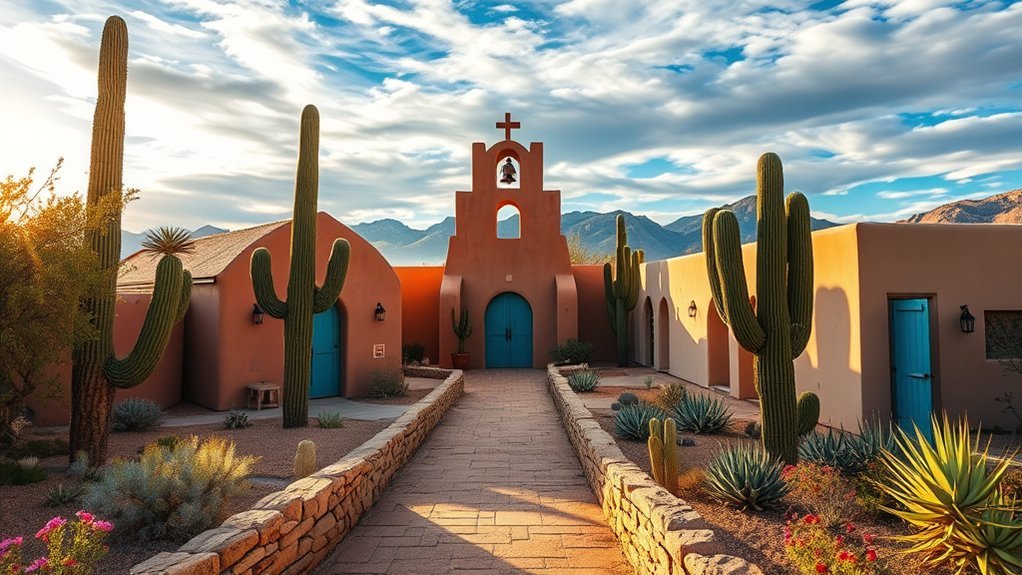
Wander into the sun-drenched DeGrazia Gallery in the Sun and you’ll find a uniquely intimate fusion of art, architecture, and desert spirit: built by artist Ettore “Ted” DeGrazia between the 1930s and 1960s, the adobe compound showcases his vibrant paintings, hand-carved details, and a chapel frescoed in warm, earthy tones. You’ll move through courtyards framed by cacti and native plants, spot kiln-fired tiles and carved wooden doors, and sense how the landscape shaped DeGrazia’s folk-modern palette. Take time in the chapel — its simple, mural-covered interior feels meditative — then wander the studios and galleries where original canvases and prints convey Southwestern life with bold color and tenderness. You can browse the gift shop for prints and ceramics, and watch occasional demonstrations or small exhibitions. These highlights help you plan a focused visit:
- Chapel murals and quiet reflection
- Original paintings and prints for sale
- Studio areas showing DeGrazia’s techniques
- Gift shop with local reproductions and crafts
Bike the Loop Multi-Use Paths
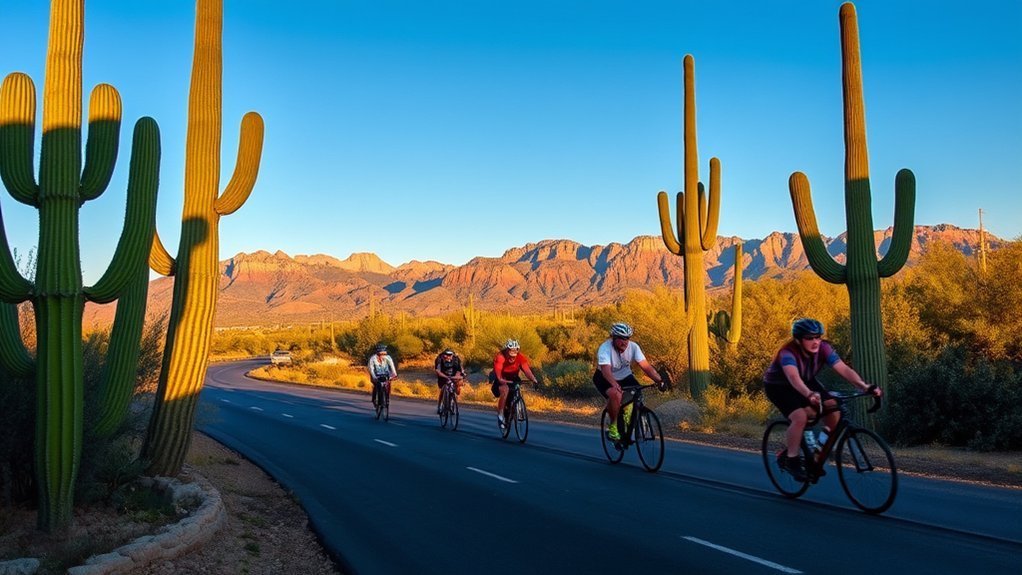
Hop on your bike and tackle The Loop, a 131-mile network of smooth, scenic multi-use paths that links parks, river corridors, and desert views—pick short stretches for easy rides or plan a longer route to hit highlights like the Rillito, Santa Cruz, and the Cañada del Oro. Follow simple safety tips—wear a helmet, use lights at dusk, signal turns, and keep right so faster riders can pass—and be mindful of pedestrians and horses. With clear signage and plenty of access points, The Loop makes it easy to plan a route that fits your pace and energy.
Route Options & Highlights
If you want a low-stress way to explore Tucson by bike, the Loop’s 131 miles of paved, multi-use paths are ideal — they connect parks, neighborhoods, and scenic river corridors while keeping you off busy streets. You can pick short loops or longer point-to-point rides, tailoring distance and scenery. Popular segments include riverside greenways, saguaro-framed stretches near parks, and urban connectors that drop you at cafes or museums. Plan for shade and water; some segments are more exposed. Notable highlights:
- Rillito River Park — flat, tree-lined, great for family rides.
- Pantano River Park — wildflower displays and quiet vistas.
- Santa Cruz River Park — historic neighborhoods and art.
- Julian Wash — expansive desert views and fewer crowds.
Each option gives distinct views of Tucson’s varied landscapes.
Safety & Trail Etiquette
After you’ve picked a route and soaked up the scenery, it helps to shift focus to staying safe and considerate on the Loop. You’ll want to obey signs and speed limits, yield to pedestrians, and announce passes with a friendly “On your left” so everyone stays predictable. Keep right except to pass, use lights and bright clothing at dawn or dusk, and wear a helmet — it’s the simplest way to reduce risk.
Carry water, sunscreen, and a basic repair kit; Tucson’s heat and distance can sneak up on you. If you stop, move entirely off the path. Respect wildlife and private property, pack out trash, and be courteous: a small gesture—slowing, smiling, yielding—keeps the Loop welcoming for all.
Take a Guided Birding Tour in Sweetwater Wetlands
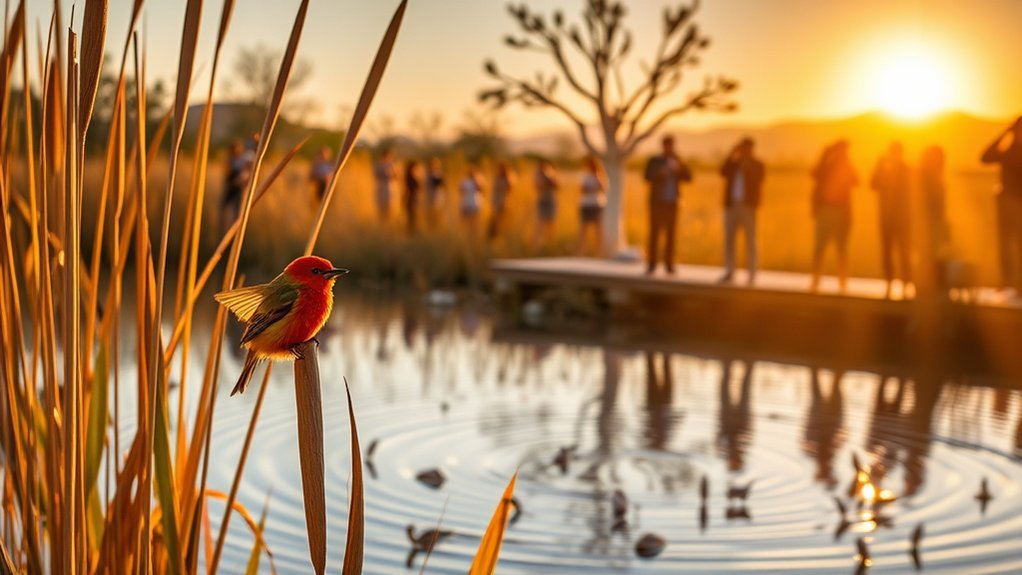
Often you’ll spot songbirds, herons, and raptors threading through the cattails as you join a guided birding tour at Sweetwater Wetlands; guides point out species, behaviors, and best viewing spots while you walk the boardwalks and observation platforms. You’ll learn to use binoculars, read subtle calls, and distinguish similar plumages, which turns fleeting sightings into lasting memories. Tours move at a comfortable pace, so you won’t miss a marsh wren’s skulking or a limpkins’ slow probe. Guides explain seasonal migrations, conservation efforts, and why the wetlands are a desert oasis for birds and people alike.
- Bring binoculars and a field guide or app.
- Wear sun protection and sturdy shoes for the boardwalks.
- Visit early morning for peak activity.
- Respect viewing distances to avoid disturbing nests.
Visit the Reid Park Zoo
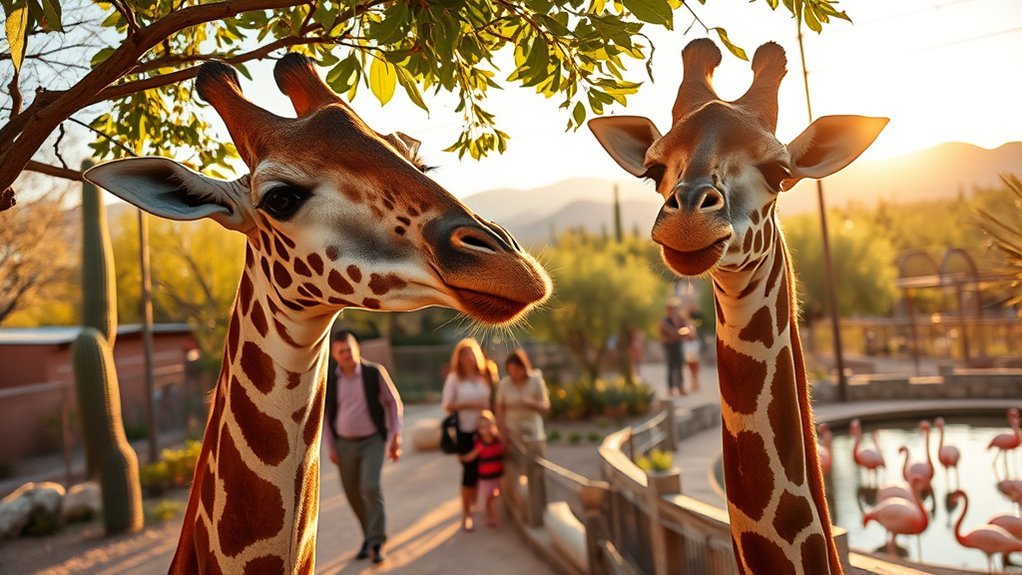
From the wetlands’ birdsong you can head into the leafy embrace of Reid Park Zoo, where compact paths and intimate exhibits bring you close to animals from around the world. You’ll stroll under mature trees past themed habitats—African savanna, Asian forest, and South American jungle—each designed for naturalistic viewing. Expect easy walking routes, shaded benches, and informative signage that explains conservation efforts and species behaviors. Kids will love the interactive play area and giraffe-feedings (check schedules), while adults can linger at the primate and big-cat enclosures to watch subtle social interactions. Seasonal events and keeper talks add context without feeling theatrical. The zoo supports local and global conservation programs, so your visit contributes to real initiatives. Practical tips: arrive early to avoid heat, wear comfortable shoes, and bring water; the layout makes it simple to set your own pace. You’ll leave with memorable close-ups and a better sense of wildlife stewardship.
Browse the Mercado San Agustin and Makers District
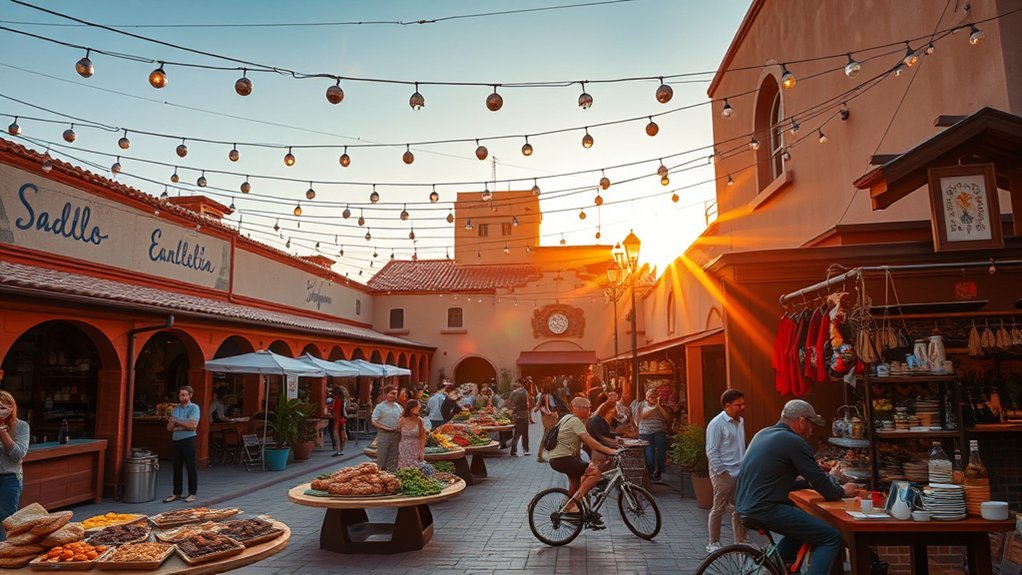
Step into Mercado San Agustín and you’ll find a lively fusion of food, craft, and community housed in a converted industrial space—think local chefs dishing up Sonoran tacos beside a bar pouring craft cocktails, while artists sell ceramics, jewelry, and prints in bright stalls. You’ll wander under exposed beams, follow the scent of grilled chilies, and chat with makers who explain techniques behind pottery glazes or block-printed textiles. The adjacent Makers District spreads that creative energy: studios, galleries, and pop-up workshops where you can watch a jeweler solder or sign up for a weekend class. Spend an hour or an afternoon tasting, buying, and learning.
Step into Mercado San Agustín — a lively hub of Sonoran flavors, handmade crafts, and hands-on creative workshops.
- Try a small-plate tasting to sample diverse vendors.
- Buy a handmade keepsake directly from the artisan.
- Watch live demos to see craft process firsthand.
- Check the events board for evening markets and live music.
Both spots reward curiosity and support Tucson’s creative community.
Tour Mission Garden and La Pilita
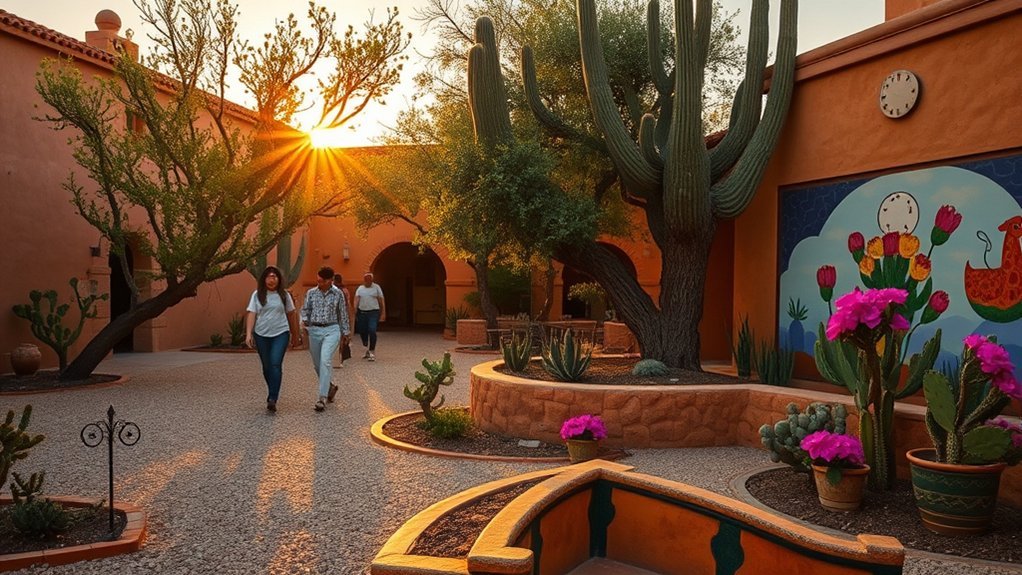
Wander through Mission Garden and you’ll encounter a living chronicle of Tucson’s agricultural roots, where heirloom crops, shaded pathways, and reconstructed mission-era plantings tell stories of Native, Spanish, and Mexican stewardship. You’ll follow narrow beds of corn, squash, and beans—the “Three Sisters”—and learn how floodplain farming and acequia irrigation shaped the valley. Signage and docent-led tours explain plant uses, trade routes, and the garden’s role in seed preservation. Nearby, La Pilita showcases community art and cultural exhibits that celebrate local history; you can catch rotating murals, interpretive displays, and occasional workshops. The site’s intimate scale invites slow exploration: pause under mesquite shade, sample heirloom varieties at special events, or photograph pollinators at dawn. Practical details—short, flat paths, shaded seating, and scheduled tours—make planning easy. Visiting Mission Garden and La Pilita gives you both an educational window into Tucson’s living landscape and a reflective, sensory stroll through centuries of cultivated tradition.
Explore Catalina State Park
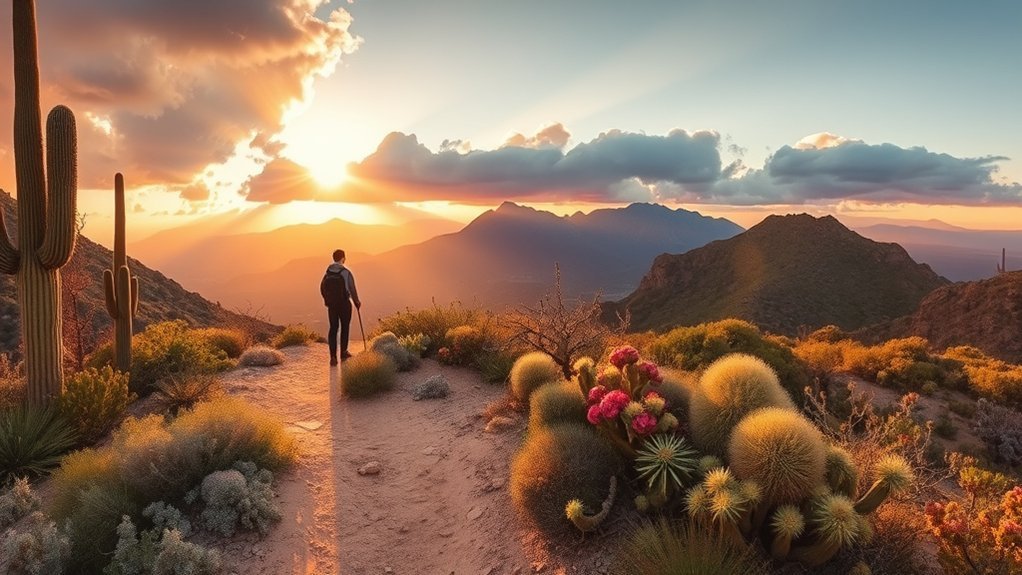
Hiking into Catalina State Park rewards you with towering saguaros, granite boulders, and sweeping Catalina Mountain views that feel both rugged and accessible. You’ll pick trails that suit your pace — from gentle loops to steep climbs — and encounter desert flora, cholla gardens, and seasonal wildflowers. Keep your camera ready: vantage points frame Tucson below and the sunrise paints the peaks. Park maps mark trailheads, picnic areas, and equestrian routes, so you can plan a hike, a bike ride, or a family outing. Bring water, sun protection, and sturdy shoes; temperatures swing quickly and shade is limited.
- Choose trails by distance and elevation to match your fitness.
- Visit early for cooler temps and active wildlife.
- Respect desert plants and pack out all trash.
- Use the interpretive signs to learn about Sonoran ecology.
You’ll leave feeling grounded by wide skies and the quiet power of the Catalina foothills.
Attend a Performance at the Tucson Fox Theatre
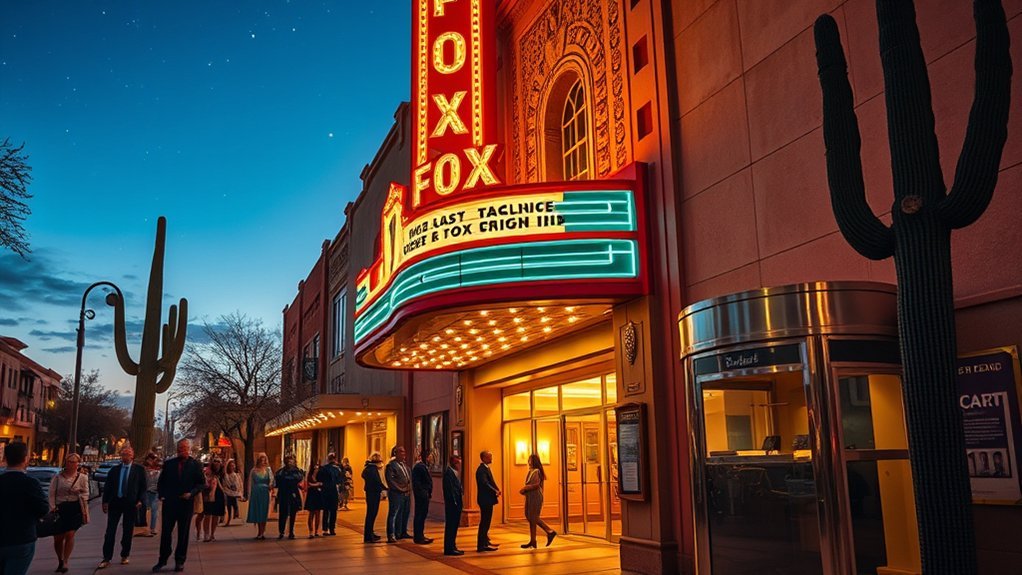
After a morning among saguaros and mountain air, head back into the city to catch an evening at the Tucson Fox Theatre, a restored 1930s movie palace whose ornate, Spanish Revival interior feels like stepping into a living piece of history. You’ll be greeted by plaster arches, colorful tile, and a hand-painted ceiling that glows under soft chandeliers. Check the schedule in advance—films, touring bands, comedy, and local productions all fill the calendar—and buy tickets early for popular shows. Arrive with time to tour the lobby, snap photos, and grab a drink at the concession bar. The acoustics are intimate; performers connect with the audience in a way big arenas can’t match. If you’re curious about behind-the-scenes history, guided tours explain the restoration and architectural details. Whether you’re into indie films, orchestras, or tribute acts, an evening here mixes culture and charm, giving you an elegant, unmistakably Tucson night out.
Experience a Sonoran-Style Hot Air Balloon Ride
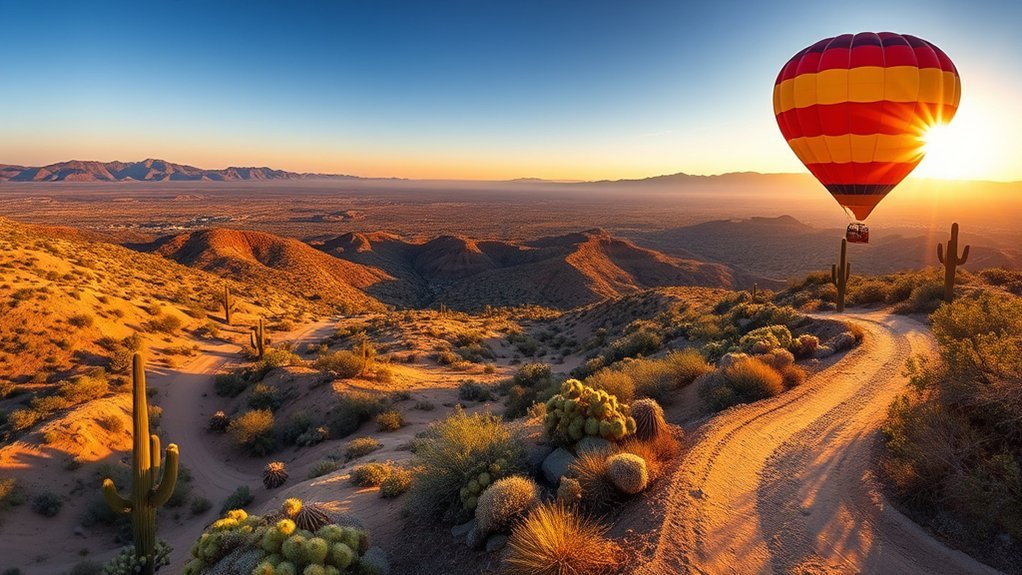
When you lift off at sunrise in a Sonoran-style hot air balloon, the desert unfolds beneath you in wide, silent swaths of creosote and saguaro silhouettes, while sunlight slices the Catalina and Rincon Mountains into layers of gold and shadow. You feel the gentle rise, the hush broken only by burners, and the cool air carries the scent of creosote after night chill. Pilots point out wildlife — javelina, coyotes, hawks — and explain desert ecology as you glide over washes and ranches. Flights last about an hour, then you descend to a quiet landing and a celebratory toast. Choose a small basket for intimacy and clearer views; dress in layers for changing temperatures.
At sunrise, a Sonoran balloon ride unfurls silent creosote and saguaro-lined vistas as burners punctuate the hush.
- Book sunrise for the best light and calm winds.
- Bring a camera with a zoom for wildlife and distant ranges.
- Wear closed shoes and sun protection.
- Confirm pilot licensing and safety briefings before takeoff.
Take a Day Trip to Kartchner Caverns State Park
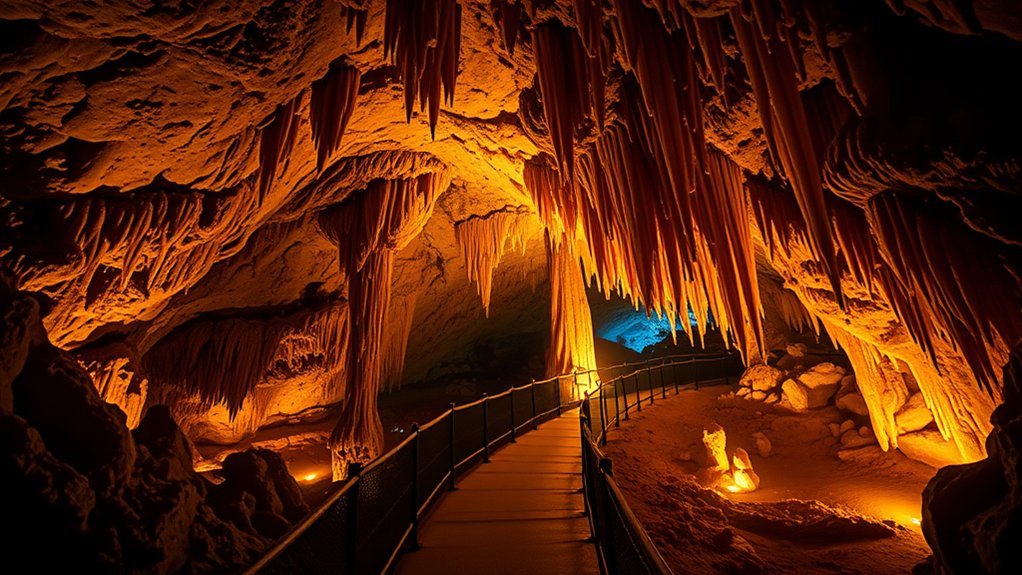
If you’re ready to trade skyward views for underground wonders, head about an hour southeast of Tucson to Kartchner Caverns State Park, where massive limestone rooms reveal dazzling stalactites, stalagmites and rare soda straws preserved in near-pristine condition. You’ll take a guided tour that controls light and humidity to protect delicate formations while explaining their slow, millimeter-by-millimeter growth over millennia. Wear comfortable shoes—the pathways are well-maintained but can be damp and cool compared with the desert heat. Bring a light jacket; cave temperatures hover around the mid-60s year-round. Outside the caverns, explore short trails through desert foothills and stop at the small visitor center to view exhibits about geology, speleothems, and conservation efforts. Reservations are recommended, especially on weekends and during holiday seasons. If you appreciate natural history and quiet, otherworldly beauty, Kartchner offers a striking contrast to Tucson’s sunlit landscapes and makes for a memorable, educational day trip.
Visit the Ronstadt Transit Center and Downtown Public Art Installations
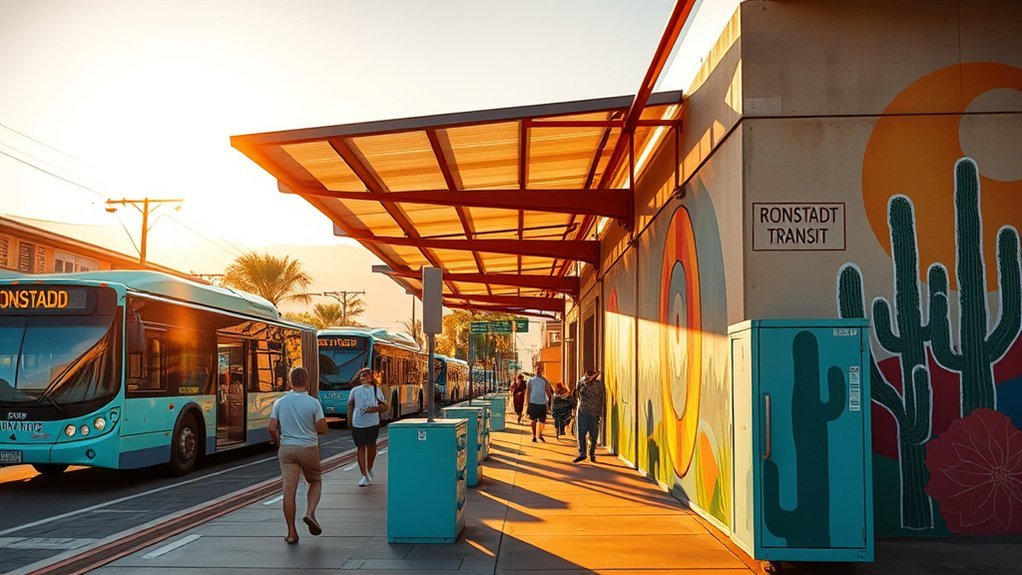
Though it sits at the heart of downtown transit, the Ronstadt Transit Center doubles as a gateway to Tucson’s vibrant public art scene, so you’ll want to step off the bus or streetcar and look around. From colorful murals to sculptural benches, the plaza and surrounding blocks showcase local artists and tell stories of Sonoran culture. You can map a short walking route that links pieces, learn about artists via plaques, and pause at shaded seating to watch daily life unfold. The nearby Mercado district and Fourth Avenue extend the artistic stroll with galleries and street performances. Bring a camera, wear comfy shoes, and plan for golden hour when light sharpens textures and colors.
- Spot large-scale murals celebrating food, history, and desert ecology
- Photograph kinetic sculptures near the trolley platforms
- Read interpretive plaques to understand context and artists
- Time your visit for pop-up markets or live music on weekends
Frequently Asked Questions
Are There Travel Options From Tucson to Mexico for a Day Trip?
Yes — you can do day trips from Tucson to Mexico: drive to Nogales, join guided border tours, or book shuttle services crossing at Nogales; carry passport, check entry/return rules, and watch crossing times and vehicle requirements.
When Is Monsoon Season and How Does It Affect Outdoor Plans?
Monsoon season runs mid-June through September, peaking July–August, and it brings sudden storms, heavy rain, lightning, and flash floods, so you’ll need flexible plans, check forecasts, carry water, avoid washes, and expect cooling storms.
What Vaccinations or Health Precautions Are Recommended for Tucson Travel?
You should be up to date on routine vaccines (MMR, Tdap, flu); consider Hep A if eating local food, stay hydrated, use sunscreen, avoid excessive sun, carry insect repellent for mosquitoes, and seek medical care for heat-related symptoms promptly.
Are There Accessibility Accommodations at Major Attractions?
Right off the bat, yes — most major attractions offer accessibility features like ramps, elevators, ADA parking, and tactile exhibits; call ahead for specifics, and they’ll bend over backward to accommodate service animals, captioning, or mobility-device needs.
Can I Bring Pets to Parks, Trails, and Outdoor Venues in Tucson?
Yes — you can bring pets to many parks, trails, and outdoor venues, but rules vary: keep pets leashed, clean up waste, and avoid sensitive habitats or restricted areas; check specific site policies and seasonal restrictions before visiting.
Conclusion
Tucson’s mix of desert drama, culture and cuisine keeps drawing you back: over 1.4 million visitors explore Saguaro National Park each year, so you’re joining a lively outdoor tradition. Whether you’re hiking among giant saguaros, wandering Barrio Viejo’s colorful streets, floating in a hot-air balloon at dawn or savoring Sonoran tacos, you’ll find surprises at every turn. Pack sun protection, an open mind and a camera—Tucson rewards curiosity.

